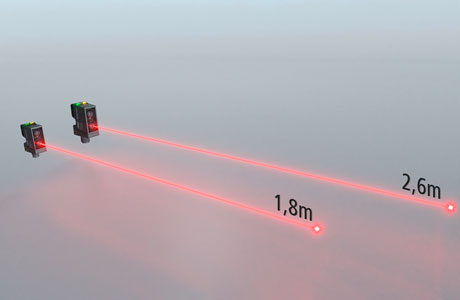Key Takeaway
The range of a photoelectric sensor depends on the type. For example, diffuse sensors can detect objects up to 1 meter away, retro-reflective sensors can reach up to 10 meters, and through-beam sensors have the longest range, up to 100 meters or more. The sensor type and the object’s surface, like its color and smoothness, also impact how far it can detect.
When choosing a sensor, it’s important to consider the environment and application. For long-range detection in open spaces, through-beam sensors are ideal. In contrast, shorter-range diffuse sensors work well for close-up detection in confined areas.
Factors That Affect the Range of Photoelectric Sensors
Photoelectric sensors don’t all work the same. The range can vary widely due to several factors. First, the sensor type itself plays a significant role. For example, diffuse sensors typically have a shorter range compared to through-beam sensors, which can detect objects at much greater distances. But that’s not all.
Environmental conditions such as dust, humidity, and even ambient light can dramatically reduce the sensor’s effective range. Additionally, the size and reflectivity of the object you’re detecting play a role. If you’re dealing with a reflective surface, you might get a longer detection range than if you’re working with a dark, matte object.
In real-world scenarios, things like sensor alignment and proper mounting also matter. Even the slightest misalignment can cut down the range significantly, so it’s crucial to get this right.

Typical Range Specifications for Various Types of Photoelectric Sensors
In industrial settings, choosing the right photoelectric sensor depends heavily on understanding its range. Through-beam sensors, for instance, are often used for long-range applications. These sensors can detect objects up to 100 meters away, making them ideal for detecting larger objects over vast distances. They consist of a transmitter and receiver, ensuring the beam remains uninterrupted unless an object is detected. However, their setup can be a bit more complex, especially when aligning both units accurately.
Retro-reflective sensors offer a mid-range option, typically detecting objects between 3 to 20 meters. These sensors use a reflector, which simplifies the setup compared to through-beam sensors. For short-range tasks, diffuse sensors are the go-to, with ranges between 10 cm to 2 meters. They rely on detecting light reflected directly off the object, perfect for precise, close-range applications. Knowing these ranges helps you select the right sensor for the task at hand.
How to Measure and Test the Range of a Photoelectric Sensor
Before installing any photoelectric sensor, testing its range is essential to ensure proper functionality. Start by aligning the sensor with the object, ensuring that all components are correctly positioned. Moving the object gradually closer and farther from the sensor can help determine its exact detection range. The key is to test with an object that matches the characteristics of what the sensor will detect in real-world conditions, such as size and reflectivity.
Many modern sensors have built-in indicators like LEDs that illuminate when the sensor detects an object. While datasheets provide the sensor’s range under ideal conditions, real-world environments often present challenges like dust or humidity. Testing ensures the sensor performs as expected in actual conditions, reducing the risk of installation issues and ensuring smooth operation.
Long-Range vs Short-Range Sensors: Which is Better for Your Application?
The choice between long-range and short-range sensors depends on the specific needs of the application. If you’re working in a vast warehouse where large objects need to be detected across long distances, through-beam sensors are a solid choice. Their long-range capabilities are unmatched. But for smaller, more precise tasks, a short-range diffuse sensor may be more appropriate. Short-range sensors are often more accurate when detecting small objects or specific positions.
For example, in packaging or assembly lines, where objects need to be detected within a close range and with precision, a diffuse sensor can outperform a long-range sensor. It’s crucial to match the sensor type to your application’s specific requirements to avoid unnecessary complications.
How Environmental Conditions Affect Sensor Range
Environmental factors like dust, humidity, and even sunlight can significantly impact the performance of photoelectric sensors. In dusty environments, light beams may become scattered, reducing the sensor’s effectiveness. Through-beam sensors tend to handle such challenges better due to their stronger, uninterrupted beam. On the other hand, retro-reflective and diffuse sensors may struggle if dust accumulates on the reflector or the object itself.
Temperature variations can also affect sensor performance. Some sensors may not function well in extreme cold or heat, so always check the sensor’s operating temperature range. For areas with high ambient light, it’s wise to choose sensors that have built-in ambient light immunity, ensuring consistent performance even in challenging environments.
Conclusion
Understanding the range of a photoelectric sensor is crucial for ensuring optimal performance in industrial applications. Factors such as environmental conditions, object size, and surface reflectivity play a significant role in determining sensor effectiveness. By selecting the right sensor for your specific environment and carefully considering these variables, you can enhance operational efficiency, improve accuracy, and minimize downtime. Properly implementing photoelectric sensors tailored to your needs will lead to smoother processes and more reliable results.
